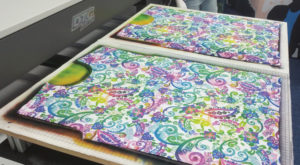 We all know how direct to garment printing has expanded over the last few years but where will it go now? What progress can we expect to see in the future? Well, the truth is we don’t have to wait because the future exists now. John-Paul Burton, director of YES Ltd explains.
We all know how direct to garment printing has expanded over the last few years but where will it go now? What progress can we expect to see in the future? Well, the truth is we don’t have to wait because the future exists now. John-Paul Burton, director of YES Ltd explains.
For many years this style of printing was only seen in the confines of T shirt decoration. Indeed the system was originally developed for the printing of small orders of T shirts.
The original DTG machines could only print CMYK and were therefore limited to printing onto white or, at best, very pale coloured shirts and the process was difficult and troublesome with many shirts ending up in the reject box. These early machines (circa early 1990s) were revised versions of then current Epson ink jet printers utilising a revised transport system allowing shirts to be mounted on a platen and fed through the machine. The print engine, being originally designed for a completely different process, was not ideal but, there again, how many other products started in this way? After all, everything has to start somewhere.
Thankfully the years since these machines first appeared have seen many developments. One of the most important was the development and introduction of white ink. This finally made it possible to print full colour onto any colour shirt including black. The machines though were still aimed at small orders and could only print, at best, up to A3. One of the obvious targets for machine manufacturers was to be able to print large format and edge to edge, and to be able to satisfy orders larger that the small quantities they were used to.
The present
That was the future but that future has now become the present. The latest batch of machines now includes models that are capable of bridging the small/bulk order gap, printing large format up to A1 and even larger. Probably more importantly is printing edge to edge. The latter is so important because, until recently, this was still the preserve of the screen printer and so those wanting this style of design had the choice of either increasing their order to a more economical level or paying a premium garment rate. Edge to edge printing has been the holy grail of DTG for a long time but the design of the machines made this impossible. The reason we can see machines capable of this now is down to the ingenuity of the machine developers.
Although there are still lots of machines out there that still depend on an existing print engine, usually from Epson, many manufacturers have gone back to basics and looked at the machine from the ground up. By doing this they have been able to design machines for a specific purpose as opposed to creating models that ‘make do’. This has resulted in machines that can achieve what was previously thought to be impossible – edge to edge printing. Much of this is down to the transport system but you also have to consider the print engine. Many new models sport bespoke print engines driven by bespoke firmware encased in bespoke cabinets in other words, a purpose designed machine.
Getting busy
One of the drawbacks right from the start has been the fact that you could only print onto 100% cotton shirts. There have always been processes around for printing onto polyester but this would mean two machines, two different sets of ink and, probably, two different headaches. Much of this of course was not a problem connected with the machines but rather the inks. Thankfully the ink manufacturers have been as busy as the machine guys and it is now possible to obtain ink that will work on 100% cotton, 100% polyester and poly/cotton blends using the same machine. DTG printing really has come of age.
So, to recap, in the space of less than 20 years, DTG printing has moved from a troublesome process confined to printing A4 onto 100% cotton white T shirts to a process that allows you to print onto any colour, a selection of fabrics, large format and edge to edge. DTG printers are no longer confined to printing shirts but, with the introduction of large format, can now print onto panels, baby clothes, cushions and a variety of other products. Now that really is a success story.
 Printwear & Promotion The Total Promotional Package
Printwear & Promotion The Total Promotional Package




